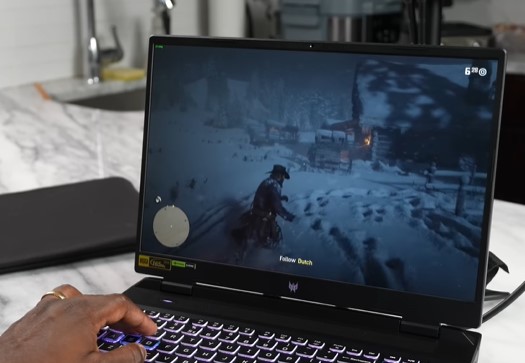The Acer Predator Helios Neo 16 emerges as a formidable contender in the realm of gaming laptops. Boasting an Intel 13th Gen processor and an RTX 4060 graphics card, it delivers robust gaming performance. Its impressive specs, including 16GB DDR5 RAM and a terabyte of storage, coupled with user-friendly upgradability, ensure it’s well-equipped for demanding tasks.
Note: This article contains Amazon affiliate links. If you make a purchase through these links, I may earn a commission at no extra cost to you.
Specifications
Acer Predator Helios Neo 16 packs some impressive specs. It’s powered by an Intel 13th Gen processor, specifically the 13700 HX, known for its desktop-class performance. Alongside, it features an RTX 4060 graphics card, ensuring top-notch gaming performance. With 16 gigabytes of lightning-fast DDR5 RAM and a spacious terabyte of storage, it’s well-equipped for demanding tasks. What’s even better is its user-friendly upgradability. With two DIMM slots for M.2 drives, expanding storage is a breeze. You can also boost the RAM up to 32 gigabytes. Additionally, the system seamlessly integrates with an extra drive for added flexibility.
Design and Build Quality

The Predator Helios Neo 16 boasts a sleek and understated design. It comes in a stylish gray finish adorned with the iconic Predator logo. Weighing in at 6.17 pounds, it strikes a balance between portability and performance. This laptop, however, doesn’t compromise on connectivity. It offers an array of ports and features, all contributing to its outstanding gaming performance, which we’ll delve into in more detail throughout this article. I won’t delve into benchmarks here because we’re already well aware of the capabilities of the Intel 13th Gen processor and the impressive performance of the RTX 4060 graphics card.

The Predator Helios Neo 16 is impressively equipped with a wide array of ports. On the right side, you’ll find two USB 3.2 ports, while the left side houses an additional USB 3.2 port, a convenient Micro SD card slot, and a combined headphone and microphone jack. Moving to the rear of the Helios Neo 16, you’ll discover an HDMI 2.1 output and a Thunderbolt 4.0 port, providing lightning-fast data transfer speeds of up to 40 gigabytes per second and enabling seamless connections to external monitors. The laptop maintains a solid and well-balanced profile, delivering a comprehensive set of connectivity options.
Keyboard and Touchpad

Acer has done an exceptional job incorporating a wealth of features into this laptop. The keyboard is seamlessly integrated into the design. It includes dedicated keys for AWSD, catering to gamers’ needs, along with a convenient Predator button that grants quick access to the Predator Sense software. Typing on this keyboard is a comfortable experience. The trackpad is also well-designed and functional. However, it’s important to note that during gaming sessions, most users prefer using a dedicated gaming mouse, making the trackpad less significant in that context.
Related: Asus ROG Strix G16 Review
Display and Audio Quality

When it comes to the display, the Predator Helios Neo 16 features a solid LED display with a notable capability, it supports a refresh rate of up to 165 Hertz, delivering a smooth gaming experience. However, there are a few noteworthy aspects to consider.
For optimal gaming performance, this system offers various fan modes and gameplay settings. You can seamlessly transition from ‘quiet’ to ‘balanced,’ then to ‘performance,’ and finally to ‘turbo.’ These settings can be accessed through the Predator Sense software, which is user-friendly, or by simply pressing the dedicated blue button on the laptop. It’s worth mentioning that the noise generated by the fan increases as you move from ‘quiet’ to ‘turbo.’ Later on, we’ll discuss how this impacts your gaming experience.
If you plan to game on the Acer Predator Helios Neo 16, it’s advisable to use a headset, especially when operating the fan at its highest setting, ‘turbo,’ as it can become quite audible and potentially interfere with your gameplay.
Performance

Turbo mode can be quite loud and often unnecessary. So, let’s dive into the performance you can expect with different fan settings on this device.
During our testing with Tomb Raider, using the ‘quiet’ fan setting, we achieved a respectable 87 frames per second at the highest game settings. When we switched to ‘balance,’ the frame rate saw a significant boost, reaching 108 frames per second. Moving on to ‘performance’ mode, which came with a noticeably louder fan noise, we hit 112 frames per second. Finally, in ‘Turbo’ mode, the frame rate peaked at 116.
From our testing, it appears that the ‘balance’ mode strikes the best balance between performance and noise level, delivering a high frame rate without the fan becoming excessively loud.
Thermals
While gaming at the balance setting, we observed temperatures ranging from 102 to 105 degrees Fahrenheit. However, when we switched to the turbo setting, the temperatures dropped down to 97 degrees. So, there are clear benefits to using ‘turbo’ as it effectively cools down the system. However, it’s worth noting that this comes at the expense of increased noise levels.
Gaming Performance

While testing with Tomb Raider, I achieved an impressive maximum frame rate of 132 frames per second at a resolution of 2560 by 1600. It performed quite well. Next, I decided to try out Red Dead Redemption 2, and the results were interesting. Playing Red Dead Redemption 2 at the maximum settings with the same resolution of 2560 by 1600, I managed to maintain a respectable 90 frames per second, which was a pleasant surprise. However, when I reduced the resolution to 1080p, the frame rates soared even higher, reaching closer to 117 frames per second. This demonstrated solid gaming performance.

Now, let’s talk about Doom Eternal, a game I absolutely love. I’m stuck on the same stage, as you can probably guess, playing it at the highest settings—Doom Eternal Max settings on Ultra Nightmare, and also at a resolution of 2560 by 1600. I’m pleased to report that the game ran remarkably well, consistently delivering frame rates ranging from 130 to 140 frames per second. These games are no pushovers, and the impressive performance we witnessed is something you can expect consistently with this system.
Conclusion
The audio quality is decent, but nothing exceptional; it’s a bit on the quieter side, with limited bass depth. However, what truly matters here is performance, and the Acer Predator Helios Neo 16 gaming laptop delivers on that front. Here’s the big kicker: it starts at just $999 for the base variant, featuring an Intel 13th Gen 13700 HX processor and an RTX 4060 graphics card. With this setup, you’re getting top-tier performance from the system. Even the slightly higher-priced variant at $1399 is a steal considering what it offers. While the Helios Neo 16 may not have a flashy design, it provides the gaming performance you’re seeking, making it a worthwhile choice for gamers.
Acer Predator Helios Neo 16 offers outstanding gaming performance at an attractive price point. With its robust specs, user-friendly design, and immersive gaming experience, it's a compelling choice for gamers seeking top-tier performance without breaking the bank.
- Design9
- Specs8.5
- Ports9
- Display8.5
- Audio7.5
- keyboard9
- Touhcpad8
- Performance8.5
- Thermals8

